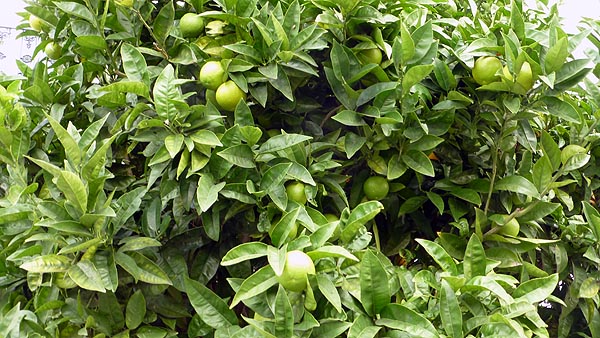......Oranges and lemons, Say the bells of St. Clement's!
Surviving due to London's heat island effect, here are some of the citrus trees that grow in London's gardens. Please contact me if you know of any others! Uncovered, in-ground plants only, please.
1. The 'Queenie' grapefruit tree in the Chelsea Physic Garden. For further details see 'World's Northernmost Fruiting Grapefruit?'
2. Unknown Bangladeshi variety in Bethnal Green - probably a pummelo variety, Citrus grandis. Private front garden - Google Maps location here
3. A grapefruit in Balham, South London. Reported and photographed early 2019 by Clive Lundquist. GoogleMaps location at 1, Hydethorpe Road.
4. A seedling orange in Shepherd's Bush






The coldest nights in southern England normally occur under clear skies and with little wind. In central London the heated buildings and stored heat in bricks and concrete counter these conditions. The map shows how central London can be about 6C warmer than the outskirts. This is known as a 'heat island' effect.
Very rarely, however, a strong easterly airflow becomes established carrying cold air from Siberia. In Winter this has become known as 'The beast from the East' and residual warmth from the heat island is rapidly carried away. This happened at the end of February 2018, when temperatures remained below freezing with strong winds for almost four days.
These conditions are the hardest for any outdoor citrus to survive in London.
Very rarely, however, a strong easterly airflow becomes established carrying cold air from Siberia. In Winter this has become known as 'The beast from the East' and residual warmth from the heat island is rapidly carried away. This happened at the end of February 2018, when temperatures remained below freezing with strong winds for almost four days.
These conditions are the hardest for any outdoor citrus to survive in London.

The first two photos show the tree in good condition with fruit in May, 2016.
A couple of years later, shown on the right, it has clearly suffered considerably from the 2018 'Beast from the East'.
A couple of years later, shown on the right, it has clearly suffered considerably from the 2018 'Beast from the East'.




CONTACT ME:
CLICK HERE TO SEND
ME A MESSAGE
CLICK HERE TO SEND
ME A MESSAGE
Page created 4th March 2019.
Added info May 2019 & April 2022 & Nov 2024 & March 2025
Added info May 2019 & April 2022 & Nov 2024 & March 2025



4. Unknown variety growing at 33, Winchester Road, Edmonton, London N9. Reported and photographed by Ahmet Kemal in May 2019.
Left photo is from Google StreetView. Captured in May 2018.
Edmonton is towards the edge of the London heat island effect, but this tree is clearly protected by being close to the house. Nonetheless, it is surprising to find such a tree thriving and fruiting here. It would be interesting to know the variety and if this is a seedling or grafted.
Edmonton is towards the edge of the London heat island effect, but this tree is clearly protected by being close to the house. Nonetheless, it is surprising to find such a tree thriving and fruiting here. It would be interesting to know the variety and if this is a seedling or grafted.
5. This tall and fruitful citrus tree at 16, Burges Road, East Ham, was reported to me by Ataur Rahman who has located several other citrus specimens growing in the north-eastern suburbs of central London.
The small orange fruit suggest it could be a mandarin variety. GoogleStreetView shows it was about 4ft tall in 2008, so is probably a seedling dating from around the year 2000.
The small orange fruit suggest it could be a mandarin variety. GoogleStreetView shows it was about 4ft tall in 2008, so is probably a seedling dating from around the year 2000.



In the same front garden is a second citrus with larger leaves but no visible fruit. It is clearly a less hardy variety which suffered greatly during the 2018 'Beast from the East freeze', as you can see from the final Google StreetView photo taken in March of that year.

6. In the front garden of 41c Claremont Road, Forest Gate, E7 is this citrus with round, yellow fruit. The photographer, Ataur Rahman, suggests this could be an example of Citrus macroptera, often called Satkora (various spellings) and used in Bangladeshi cooking. A closer look at the leaf shape could confirm this as C. macroptera has very large winged petioles.
Do you know of other citrus trees growing outside in the London area?

7. Unknown large leafed citrus variety at 61 Glenparke Rd, E7 8BW




8. In the front garden of 73, Earl's Court Road, Kensington is this mature orange tree. Reported to me by Pascal Binon and Franck-albert Buisson from the French Facebook group Groupe de Fous d'Agrumes
Photographed in November 2024, the tree was carrying a reasonable crop of still green oranges.



These images from GoogleMaps street view show the tree in 2008, 2015 and 2023. They suggest the tree is probably about 20 or 25 years old.
In early 2025 I received an e-mail from garden designer Pip who reported seeing a citrus tree in Queenstown Road, Battersea, London. In March 2025 I paid a visit and found a very fine specimen growing in the front garden of number 69. The tree was about 6m to 8m tall, covered more than the whole garden and looked very healthy.
At first, from the size and shape of the large leaves, I thought this could be a pummelo (or pomelo, Citrus maxima) but the fruit characteristics - including taste - proved it to be a grapefruit, Citrus paradisi.
At first, from the size and shape of the large leaves, I thought this could be a pummelo (or pomelo, Citrus maxima) but the fruit characteristics - including taste - proved it to be a grapefruit, Citrus paradisi.


The tree was carrying a fair number of large yellow fruit, spherical or slightly oblate, mostly hidden by foliage. The black marks are the inevitable result of scale insects and other pests excreting honeydew.


There were several rotting fruit on the ground but I managed to reach this one stll in reasonable condition and bring it home. The flesh was yellow and juicy, fairly acidic but definitely edible and tasting like a typical bitter grapefruit.

This is the GoogleMaps Street View image dating from 2012.
The tree filled the whole of the front garden even then. Must be very dark inside the house!
The tree filled the whole of the front garden even then. Must be very dark inside the house!
Leaves were up to 15 cms long and many with large winged petioles. This is often a feature of pummelos but also some grapefruit varieties.
Do you know of other citrus trees growing outside in the London area?
